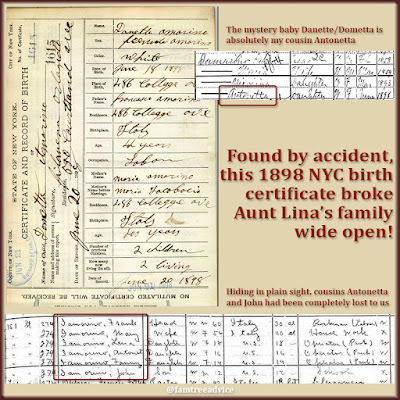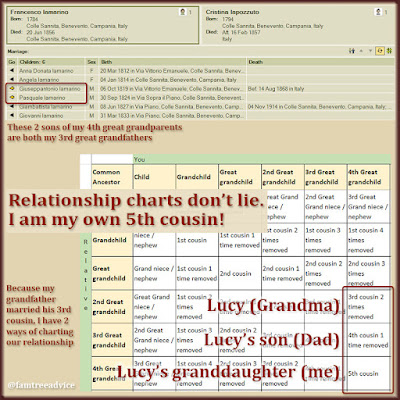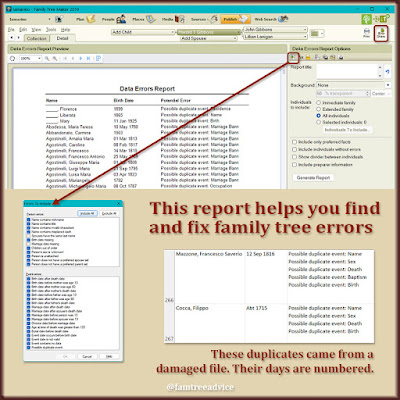Last week I was trying to find a particular birth record on the New York City Municipal Archives' website (see Day 5 of 7 Days to a Better Family Tree). I didn't have the certificate number, so I did a broad search for births in the Bronx within a span of years.
The certificates in my search results didn't show names—only numbers. I had to open each one to see if it was the birth record I needed. One record struck me as a possible misspelling of my own last name, Iamarino. The baby's name, written twice on the document, looks like Danette or Dometta Amarino. The parents are Francesco Amarino and Maria Iacobacia.
That combination of names rang a bell. My 3rd great uncle Francesco (Saverio) Iamarino married (Anna) Maria Iacobaccio. They emigrated to New York. My dad remembers two of their U.S.-born children as his "aunts" Lina and Filly, as well as Filly's sons.
But baby "Danette," born in the Bronx in 1898, was not someone I'd ever heard mentioned. Was she really my 1st cousin 3 times removed, or was this combination of parents' names a coincidence?
I was about to delete her downloaded birth record. But then I took another look at her potential father in my family tree. I had only his 1855 Italian birth record and his 1937 New York death certificate.
 |
| Found by accident, downloaded on a hunch, this birth certificate helped break down a brick wall in my family tree. |
I needed to find some censuses for this family. My search on Ancestry delivered the family in 1900, 1915, and 1920. I found "Aunt" Lina on the 1900 census using what I always imagined was her real name: Nicolina.
But there was a surprise on the 1900 census. Nicolina had a 2-year-old sister named Antonetta.
Hold on a minute! I said that name aloud the way a Southern Italian immigrant might pronounce it: Ondonet. (See Look Past the Misspellings to Find Your Ancestors.) The 1898 birth certificate I found by accident was baby Antonetta, misunderstood by the clerk as Danette or Dometta. She was my cousin after all!
The New York State census for 1915 further supported "Danette" being my cousin. This year the family included both "aunts" Lina and Filly. And also my newly discovered "aunt" Antonetta. But there was another surprise. The family added a son in 1903 named John. My dad and I had never heard of him, either.
The 1920 census held yet another surprise. Lina is missing, having married in 1919. Antonette and John are there, and they wrote Filly's name as Filomino. This tells me her real name was Filomena, as I'd always suspected. Later in life she Americanized it to Phyllis.
But the surprise was the family's location. They're not in the Bronx, even though the head of the household would die there 17 years later. They're in North Brunswick, New Jersey.
You might think I would dismiss this as being the wrong family. But I knew there was a connection to New Brunswick, which borders North Brunswick. I have a few 1930s photographs of my dad and his family standing beside a car in front of the New Brunswick City Yards.
 |
| It was a collection of old photos in front of the "New Brunswick City Yards" that told me I was on the right track. |
I wish I could find this building! But New Brunswick has been rebuilt over the years, thanks to Rutgers University and factory closings. I searched for historic photos of the area with no luck.
The connection to North Brunswick interested me because I lived there in 1985–1986. I discovered they lived in the village of Adams Station. I actually worked in that village and lived a mile up the road.
I really needed to find the family in the 1930 census, but I couldn't find them by name. So I searched the census records by location only. North Brunswick, New Jersey, had only 2 districts in 1930, so I could browse them page by page.
They conducted the 1930 census in April—2 months after my 3rd great uncle's wife died. Will her family still be there? Aunt Filly was with her husband in New Brunswick. Aunt Lina was with her husband in the Bronx. Their brother John may have married that year. I had 74 pages of census to go through. With 20 pages left to go, I found them!
Just as I was losing hope, I spotted the name Marino. There was Frank, a 77-year-old widow, his 25-year-old son John, and John's new wife Rosie. This census had no street names or house numbers. It was simply the Adams section of North Brunswick.
I went on to find John, the son of my 3rd great uncle, in the 1940 and 1950 censuses. Although he was in a different house each time, he was always two-and-a-half miles from where I lived 13 years after his death.
I've spent hours gathering this family's records and putting tons of facts into my family tree. I've taken this family in unexpected directions. And it was all because a name on a random birth certificate seemed to me like it should be my family.
If you have a hunch about a slightly "off" genealogy find, follow your instincts. Do the research and prove that the person is either in or out of your family tree.









